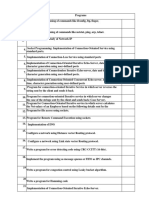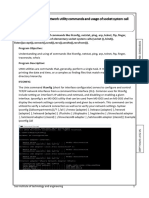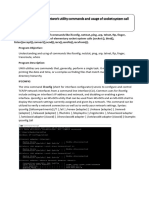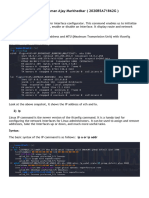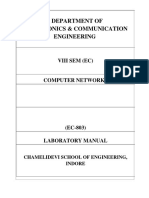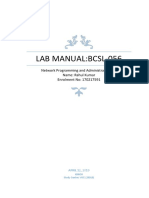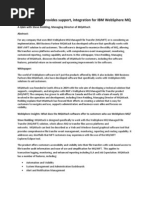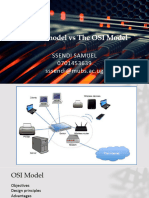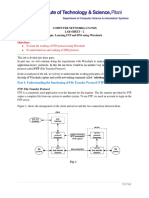1 Network Familiarization Commands
Uploaded by
kingmaster2081431 Network Familiarization Commands
Uploaded by
kingmaster208143Program 1: Familiarity with basics of network configuration files and networking
commands in Linux - ifconfig, netstat, ping, arp, telnet, ftp, finger.
Program Objective:
Understanding and using of commands like ifconfig, netstat, ping, arp, telnet, ftp, finger,
traceroute, whois
Program Description:
UNIX utilities are commands that, generally, perform a single task. It may be as simple as
printing the date and time, or a complex as finding files that match many criteria throughout a
directory hierarchy
IFCONFIG
The Unix command ifconfig (short for interface configurator) serves to configure and control
TCP/IP network interfaces from a command line interface (CLI).
Common uses for ifconfig include setting an interface's IP address and netmask, and disabling or
enabling a given interface. On some Unix-like operating systems, ifconfig is used to configure,
or view the configuration of, a network interface.
Type ipconfig/all to see detailed configuration information for all network adapters configured
on the computer.
The ipconfig (short for IP Configuration) is a basic, yet popular, Windows network command-
line utility used to display the TCP/IP network configuration of a computer. If you are familiar
with Linux, this tool is similiar to ifconfig. This tool is often used for troubleshooting network
connectivity issues. With ipconfig, you can identify the types of network adapaters on your
computer, the computer's IP address, the IP addresses of the DNS (Domain Name System)
servers being used, and much more.
ifconfig -a
Displays the configuration of all interfaces, both active and inactive.
NETSTAT
netstat (network statistics) is a command-line tool that displays network connections (both
incoming and outgoing), routing tables, and a number of network interface statistics.
It is used for finding problems in the network and to determine the amount of traffic on the
network as a performance measurement.
Parameters
Parameters used with this command must be prefixed with a hyphen (-) rather than a slash (/).
-a : Displays all active TCP connections and the TCP and UDP ports on which the computer is
listening.
-e : Displays ethernet statistics, such as the number of bytes and packets sent and received. This
parameter can be combined with -s.
-f : Displays fully qualified domain names <FQDN> for foreign addresses.
-i : Displays network interfaces and their statistics (not available under Windows)
-n : Displays active TCP connections, however, addresses and port numbers are expressed
numerically and no attempt is made to determine names.
-o : Displays active TCP connections and includes the process ID (PID) for each connection.
-p Linux: Process : Show which processes are using which sockets
Department of Computer Science and Engineering, LMCST 1
PING
Ping is a computer network tool used to test whether a particular host is reachable across an IP
network; it is also used to self-test the network interface card of the computer, or as a speed test.
It works by sending ICMP “echo request” packets to the target host and listening for ICMP
“echo response” replies. Ping does not estimate the round-trip time, as it does not factor in the
user's connection speed, but instead is used to record any packet loss, and print a statistical
summary when finished.
The word ping is also frequently used as a verb or noun, where it is usually incorrectly used to
refer to the round-trip time, or measuring the round-trip time. The ping command can be used to
test end-to-end connectivity between two host devices. It measures the round-trip time for a
message to get from source to destination. The ping command can be used to verify the
connectivity between two network devices that are IP (Internet Protocol) based.
ARP
In computer networking, the Address Resolution Protocol (ARP) is the method for finding a host's
link layer (hardware) address when only its Internet Layer (IP) or some other Network Layer address
is known.
ARP has been implemented in many types of networks; it is not an IP-only or Ethernet-only protocol.
It can be used to resolve many different network layer protocol addresses to interface hardware
addresses, although, due to the overwhelming prevalence of IPv4 and Ethernet, ARP is primarily
used to translate IP addresses to Ethernet MAC addresses.
How to Use ARP to Find a MAC Address
In Windows, Linux, and other operating systems, the command line utility ARP (Address Resolution
Protocol) shows local MAC address information stored in the ARP cache. However, it only works
within the small group of computers on a local area network (LAN), not across the internet.
ARP is intended to be used by system administrators, and it is not typically a useful way to track
down computers and people on the internet.
TCP/IP computer networks use both the IP addresses and MAC addresses of connected client devices.
While the IP address changes over time, the MAC address of a network adapter always stays the
same.
Start by pinging the device you want the MAC to address for:
ping 192.168.86.45
The ping command establishes a connection with the other device on the network and should show a
result like this:
Pinging 192.168.86.45 with 32 bytes of data:
Reply from 192.168.86.45: bytes=32 time=290ms TTL=128
Reply from 192.168.86.45: bytes=32 time=3ms TTL=128
Reply from 192.168.86.45: bytes=32 time=176ms TTL=128Reply from 192.168.86.45: bytes=32
time=3ms TTL=128
Use the following ARP command to get a list that shows the MAC address of the device you pinged:
arp -a
The results may look something like this but probably with many other entries:
Department of Computer Science and Engineering, LMCST 2
Interface: 192.168.86.38 --- 0x3
Internet Address Physical Address Type
192.168.86.1 70-3a-cb-14-11-7a dynamic
192.168.86.45 98-90-96-B9-9D-61 dynamic
192.168.86.255 ff-ff-ff-ff-ff-ff static
224.0.0.22 01-00-5e-00-00-16 static
224.0.0.251 01-00-5e-00-00-fb static
Find the device's IP address in the list. The MAC address is shown right next to it. In this example,
the IP address is 192.168.86.45, and its MAC address is 98-90-96-B9-9D-61.
TELNET
Telnet (Telecommunication network) is a network protocol used on the Internet or local area
network (LAN) connections. In Linux, the telnet command is used to create a remote connection
with a system over a TCP/IP network.
Typically, telnet provides access to a command-line interface on a remote machine.
The term telnet also refers to software which implements the client part of the protocol. Telnet
clients are available for virtually all platforms.
Protocol details:
Telnet is a client-server protocol, based on a reliable connection-oriented transport. Typically
this protocol is used to establish a connection to TCP port 23
FTP
File Transfer Protocol (FTP):
FTP is a network protocol used to transfer data from one computer to another through a network
such as the Internet.FTP is a file transfer protocol for exchanging and manipulating files over a
TCP computer network. An FTP client may connect to an FTP server to manipulate files on that
server.FTP runs over TCP. It defaults to listen on port 21 for incoming connections from FTP
clients. A connection to this port from the FTP Client forms the control stream on which
commands are passed from the FTP client to the FTP server and on occasion from the FTP
server to the FTP client. FTP uses out-of-band control, which means it uses a separate
connection for control and data. Thus, for the actual file transfer to take place, a different
connection is required which is called the data stream.
To establish an FTP connection to a remote system, use the ftp command with the remote
system's IP address:
ftp [IP]
For instance, connecting to a remote server with the IP address 192.168.100.9:
ftp 192.168.100.9
FINGER:
In computer networking, the Name/Finger protocol and the Finger user information protocol
are simple network protocols for the exchange of human-oriented status and user information.
Department of Computer Science and Engineering, LMCST 3
Finger command is a user information lookup command which gives details of all the users
logged in. This tool is generally used by system administrators. It provides details like login
name, user name, idle time, login time, and in some cases their email address even.
finger -p ch
Display information about the user ch. Output appears similar to the following:
Login name: admin
In real life: Computer Hope
On since Feb 11 23:37:16 on pts/7 from domain.computerhope.com
28 seconds Idle Time
Unread mail since Mon Feb 12 00:22:52 2001
TRACEROUTE:
traceroute is a computer network tool used to determine the route taken by packets across an IP
network . An IPv6 variant, traceroute6, is also widely available. Traceroute is often used for
network troubleshooting. By showing a list of routers traversed, it allows the user to identify the
path taken to reach a particular destination on the network. This can help identify routing
problems or firewalls that may be blocking access to a site. Traceroute is also used by
penetration testers to gather information about network infrastructure and IP ranges around a
given host. It can also be used when downloading data, and if there are multiple mirrors available
for the same piece of data, one can trace each mirror to get a good idea of which mirror would be
the fastest to use.
In other words, traceroute command in Linux prints the route that a packet takes to reach the host.
This command is useful when you want to know about the route and about all the hops that a
packet takes.
The traceroute command in Windows is tracert. On a Linux system, the command is traceroute.
A typical tracert on a Windows machine would look like the following.
tracert www.google.com
Tracing route to www.google.com [74.125.227.179]
over a maximum of 30 hops:
1 1 ms <1 ms 1 ms 192.168.1.1
2 7 ms 6 ms 6 ms 10.10.1.2
3 7 ms 8 ms 7 ms 10.10.1.45
4 9 ms 8 ms 8 ms 10.10.25.45
5 9 ms 10 ms 9 ms 10.10.85.99
6 11 ms 51 ms 10 ms 10.10.64.2
7 11 ms 10 ms 10 ms 10.10.5.88
8 11 ms 10 ms 11 ms 216.239.46.248
9 12 ms 12 ms 12 ms 72.14.236.98
10 18 ms 18 ms 18 ms 66.249.95.231
11 25 ms 24 ms 24 ms 216.239.48.4
12 48 ms 46 ms 46 ms 72.14.237.213
Department of Computer Science and Engineering, LMCST 4
13 50 ms 50 ms 50 ms 72.14.237.214
14 48 ms 48 ms 48 ms 64.233.174.137
15 47 ms 47 ms 46 ms dfw06s32-in-f19.1e100.net [74.125.227.179]
Trace complete.
For all additional options of traceroute, check the manual page in the terminal with the man
command:
man traceroute
WHO IS:
WHOIS (pronounced "who is"; not an acronym) is a query/response protocol which is widely
used for querying an official database in order to determine the owner of a domain name, an IP
address, or an autonomous system number on the Internet. WHOIS lookups were traditionally
made using a command line interface, but a number of simplified web-based tools now exist for
looking up domain ownership details from different databases. WHOIS normally runs on TCP
port 43.
The WHOIS system originated as a method that system administrators could use to look up
information to contact other IP address or domain name administrators (almost like "white
pages").
whois 216.58.206.46
The following results may also be obtained via:
https://whois.arin.net/rest/nets;q=216.58.206.46?showDetails=true&showARIN=false&showNo
nArinTopLevelNet=false&ext=netref2
NetRange: 216.58.192.0 - 216.58.223.255
CIDR: 216.58.192.0/19
NetName: GOOGLE
NetHandle: NET-216-58-192-0-1
Parent: NET216 (NET-216-0-0-0-0)
NetType: Direct Allocation
OriginAS: AS15169
Organization: Google LLC (GOGL)
RegDate: 2012-01-27
Department of Computer Science and Engineering, LMCST 5
Updated: 2012-01-27
Ref: https://whois.arin.net/rest/net/NET-216-58-192-0-1
OrgName: Google LLC
OrgId: GOGL
Address: 1600 Amphitheatre Parkway
City: Mountain View
StateProv: CA
PostalCode: 94043
Country: US
RegDate: 2000-03-30
Updated: 2017-12-21
Ref: https://whois.arin.net/rest/org/GOGL ...
whois google.com
Domain Name: GOOGLE.COM
Registry Domain ID: 2138514_DOMAIN_COM-VRSN
Registrar WHOIS Server: whois.markmonitor.com
Registrar URL: http://www.markmonitor.com
Updated Date: 2011-07-20T16:55:31Z
Creation Date: 1997-09-15T04:00:00Z
Registry Expiry Date: 2020-09-14T04:00:00Z
Registrar: MarkMonitor Inc.
Registrar IANA ID: 292
Registrar Abuse Contact Email: abusecomplaints@markmonitor.com
Registrar Abuse Contact Phone: +1.2083895740
Domain Status: clientDeleteProhibited https://icann.org/epp#clientDeleteProhibited
Department of Computer Science and Engineering, LMCST 6
Domain Status: clientTransferProhibited https://icann.org/epp#clientTransferProhibited
Domain Status: clientUpdateProhibited https://icann.org/epp#clientUpdateProhibited
Domain Status: serverDeleteProhibited https://icann.org/epp#serverDeleteProhibited
Domain Status: serverTransferProhibited https://icann.org/epp#serverTransferProhibited
Domain Status: serverUpdateProhibited https://icann.org/epp#serverUpdateProhibited
Name Server: NS1.GOOGLE.COM
Name Server: NS2.GOOGLE.COM
Name Server: NS3.GOOGLE.COM
Name Server: NS4.GOOGLE.COM
Department of Computer Science and Engineering, LMCST 7
You might also like
- IT-IAS02: Information Assurance and Security 2100% (1)IT-IAS02: Information Assurance and Security 246 pages
- Top 30 Linux System Admin Interview Questions & AnswersNo ratings yetTop 30 Linux System Admin Interview Questions & Answers16 pages
- 10 Free Ways To Download All Files From A Folder On A Website or FTP - Raymond - CCNo ratings yet10 Free Ways To Download All Files From A Folder On A Website or FTP - Raymond - CC13 pages
- Experiment No. 1: Name: - Aditi A Jadhav Class: - Be/Extc ROLL NO: - 114 Subject: - Internet Communication EngineeringNo ratings yetExperiment No. 1: Name: - Aditi A Jadhav Class: - Be/Extc ROLL NO: - 114 Subject: - Internet Communication Engineering6 pages
- Identify and Resolve Network Problems: NAME: Nahom Alemseged ID: 18/14 Teacher's Name: Nigist DateNo ratings yetIdentify and Resolve Network Problems: NAME: Nahom Alemseged ID: 18/14 Teacher's Name: Nigist Date7 pages
- Lab 01: Basic Networking Commands: IpconfigNo ratings yetLab 01: Basic Networking Commands: Ipconfig9 pages
- Name: Shruti Kitukale Sec/semester:A-5 Course Name: Computer Networks Lab Roll No: 25 Enroll No.:19010243No ratings yetName: Shruti Kitukale Sec/semester:A-5 Course Name: Computer Networks Lab Roll No: 25 Enroll No.:1901024312 pages
- Object:: Data Communication and Computer NetworkNo ratings yetObject:: Data Communication and Computer Network9 pages
- Practical: - 1 Aim: - Execution of Basic TCP/IP Utilities and CommandsNo ratings yetPractical: - 1 Aim: - Execution of Basic TCP/IP Utilities and Commands100 pages
- Lab Manual:Bcsl-056: Network Programming and Administrative Lab Name: Rahul Kumar Enrolment No: 170217591No ratings yetLab Manual:Bcsl-056: Network Programming and Administrative Lab Name: Rahul Kumar Enrolment No: 17021759134 pages
- CISCO PACKET TRACER LABS: Best practice of configuring or troubleshooting NetworkFrom EverandCISCO PACKET TRACER LABS: Best practice of configuring or troubleshooting NetworkNo ratings yet
- MIS & DSS - Solutions To Previous Year Questions100% (1)MIS & DSS - Solutions To Previous Year Questions57 pages
- Alfresco Day Zero Configuration Guide v0.14No ratings yetAlfresco Day Zero Configuration Guide v0.1422 pages
- Computer Networks Two Marks With AnswerNo ratings yetComputer Networks Two Marks With Answer16 pages
- Industries: Maxx Mobile, Cavinkare, Micron, Ses, Simmtronics and CadenceNo ratings yetIndustries: Maxx Mobile, Cavinkare, Micron, Ses, Simmtronics and Cadence48 pages
- Business Communication MCQs Related To Email - CSEET - Artha CSNo ratings yetBusiness Communication MCQs Related To Email - CSEET - Artha CS17 pages
- Micro Project Report: (Your Guide Name)No ratings yetMicro Project Report: (Your Guide Name)28 pages
- Top 30 Linux System Admin Interview Questions & AnswersTop 30 Linux System Admin Interview Questions & Answers
- 10 Free Ways To Download All Files From A Folder On A Website or FTP - Raymond - CC10 Free Ways To Download All Files From A Folder On A Website or FTP - Raymond - CC
- Experiment No. 1: Name: - Aditi A Jadhav Class: - Be/Extc ROLL NO: - 114 Subject: - Internet Communication EngineeringExperiment No. 1: Name: - Aditi A Jadhav Class: - Be/Extc ROLL NO: - 114 Subject: - Internet Communication Engineering
- Identify and Resolve Network Problems: NAME: Nahom Alemseged ID: 18/14 Teacher's Name: Nigist DateIdentify and Resolve Network Problems: NAME: Nahom Alemseged ID: 18/14 Teacher's Name: Nigist Date
- Name: Shruti Kitukale Sec/semester:A-5 Course Name: Computer Networks Lab Roll No: 25 Enroll No.:19010243Name: Shruti Kitukale Sec/semester:A-5 Course Name: Computer Networks Lab Roll No: 25 Enroll No.:19010243
- Practical: - 1 Aim: - Execution of Basic TCP/IP Utilities and CommandsPractical: - 1 Aim: - Execution of Basic TCP/IP Utilities and Commands
- Lab Manual:Bcsl-056: Network Programming and Administrative Lab Name: Rahul Kumar Enrolment No: 170217591Lab Manual:Bcsl-056: Network Programming and Administrative Lab Name: Rahul Kumar Enrolment No: 170217591
- CISCO PACKET TRACER LABS: Best practice of configuring or troubleshooting NetworkFrom EverandCISCO PACKET TRACER LABS: Best practice of configuring or troubleshooting Network
- Industries: Maxx Mobile, Cavinkare, Micron, Ses, Simmtronics and CadenceIndustries: Maxx Mobile, Cavinkare, Micron, Ses, Simmtronics and Cadence
- Business Communication MCQs Related To Email - CSEET - Artha CSBusiness Communication MCQs Related To Email - CSEET - Artha CS






